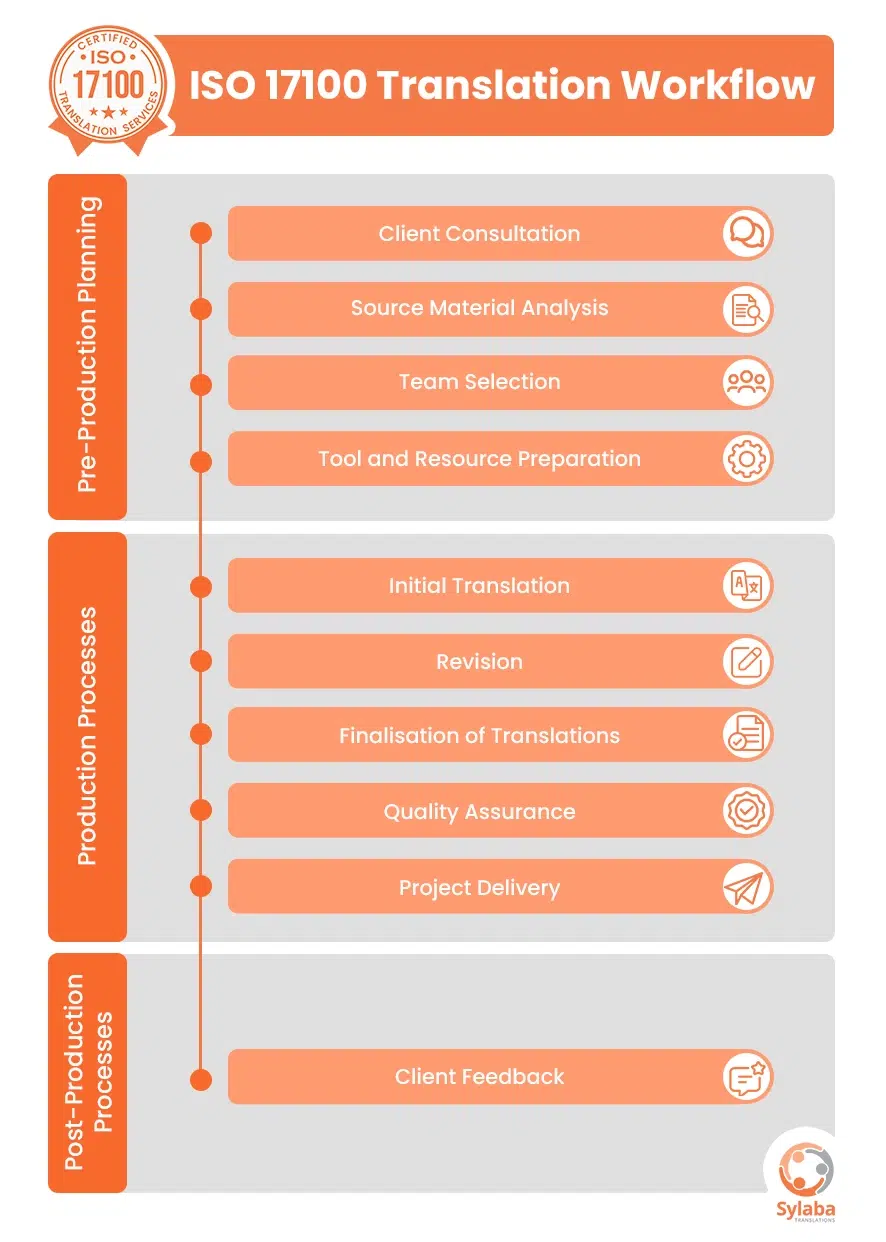Businesses and organisations are increasingly operating across cultural and linguistic boundaries. This expansion brings the challenge of communicating effectively in a world rich with linguistic diversity.
For businesses aiming to connect with new markets and for communities striving to embrace multicultural inclusivity, the role of high-quality translation services becomes pivotal. Yet, how can you ensure that translations are up to the task?
ISO 17100 : 2015 Translation Services, the international standard for quality translation services, ensures that every translation service adheres to the highest standards of quality and professionalism, making it a crucial deciding factor for anyone needing reliable translation services.
In this article, we will explore ISO 17100 in detail and discuss how it helps you choose the right Translation Service Provider (TSP).
Let’s take a closer look.
What is ISO 17100?
ISO 17100 is a globally recognised standard, established by the International Organisation for Standardisation (ISO), specifically designed for the translation services industry.
This standard sets out the requirements for all aspects of the translation process that directly affect the quality and delivery of translation services. It covers core processes, resources, and other aspects necessary to provide consistent high quality translation service.
The role of ISO in establishing global standards spans various industries, ensuring that products and services are safe, reliable, and of good quality. For translation services, ISO 17100 provides a framework that specifies the qualifications of the professionals involved, the execution of the translation process, and the implementation of quality control measures.
This guarantees that businesses, organisations, and individuals can rely on ISO 17100 certified providers to deliver accurate and consistent high-quality translations that meet their specific needs.
Understanding the components of ISO 17100 reveals why it’s considered the benchmark for quality in translation services.
ISO 17100 In Depth
ISO 17100 provides a comprehensive framework that ensures that every aspect of the translation workflow, from project initiation to completion, adheres to the highest quality standards.
The ISO 17100 standard organises the translation process into two main stages: pre-production and production, each with specific activities designed to ensure quality and efficiency.
Pre-production Planning
Before the actual translation begins, a series of preparatory steps ensure that the project is accurately scoped and planned:
1. Client Consultation: A thorough consultation takes place to clearly understand your project’s goals, target audience, and any specific requirements. This allows for the selection of the most suitable translation team and a tailored approach specifically to your project.
2. Source Material Analysis: A comprehensive review of your source material to assess the complexity of content and identify potential challenges. A translation brief is created, outlining the project’s purpose, target audience, and specific instructions on any formatting requirements, terminology preferences, or guidelines for handling sensitive information, project deadlines, and any resource materials, ensuring the translation team is well-informed and prepared.
3. Team Selection: Based on your project, a team of certified translators, domain specialist reviewers, and competent project managers who meet ISO 17100 qualifications is selected. With the adherence to the ISO 17100 standard, this guarantees that they possess the proper training, required language skills, subject-matter expertise, and cultural understanding to the project.
4. Tool and Resource Preparation: The translation team is equipped with the necessary tools and resources, such as translation memories, glossaries, and style guides. This step ensures consistency and quality throughout the process.
After these preparatory steps, a robust production workflow follows.
Production Processes
This stage is where the translations take shape:
1. Initial Translation: The assigned certified translator(s) translate your content into the target language, adhering to project requirements, glossaries, style guides, and other resources. They ensure the translation is faithful to the intended message, while maintaining proper grammar, sentence structure, and cultural appropriateness. Before delivering the initial translation, assigned translator(s) proofread their work for any issues and ensures it adheres to the translation brief.
2. Revision: A qualified reviewer, with expertise in both the target language and the subject matter, reviews the translation against the source content. They check for any errors, inconsistencies, readability issues, and cultural nuances. They suggest necessary changes to ensure the translation is flawless. This revision process continues until both the reviewer and the team are satisfied.
3. Finalisation of Translations: Any revisions or corrections identified by the reviewer are addressed by the translator. This guarantees consistent accuracy and cultural appropriateness throughout the translation.
4. Quality Assurance: A final quality control step is conducted by a qualified linguist or project manager. This involves thorough review of the translated material against the source material for any formatting or layout issues and to assess if the assigned translator(s) followed the translation brief. This ensures the final translations meet your requirements, align with the project’s objectives set during the planning stage, and adhere to the ISO 17100 translation standard.
5. Project Delivery: Once the translations pass all quality checks, the final translated materials are delivered to you, ensuring they meet your project’s objectives and fulfill your requirements.
The process doesn’t stop at delivery. ISO 17100 also emphasizes the importance of client feedback.
Post-production processes
- Client Feedback: This step provides you with the opportunity to share your feedback regarding the delivered translated materials. You can address any concerns or request any final adjustments to ensure that the translation aligns perfectly with your expectations and requirements.
Beyond the process, ISO 17100 emphasizes the importance of resources—both human and technology—that support high-quality translations:
Qualifications and Experience: The ISO standard has clearly stipulated the qualification and competences for translators in the ISO 17100 standards for translators, reviewers, and project managers. Only those who meet the criteria are eligible to work on translation projects.
For instance, translators need to have 2-5 years of professional experience in translating and need may hold certifications like NAATI. Reviewers must be domain specialists or subject matter experts in the project’s industry. Project managers have acquired formal or in-house training and developed an extensive understanding of the translation industry, the translation process and mastered project management skills.
By only working with ISO 17100 certified professionals, translation service providers can assure you that they can deliver high-quality work.
Technology and Tools: The use of advanced technology and tools, such as translation memory software, is leveraged to streamline the translation process and ensure consistency across projects.
Adherence to ISO 17100 translation standard assures clients of the reliability and quality of translation services as they follow a rigorous translation process and extensive selection of qualified professionals that will carry out your translation project.
Why is ISO 17100 Important?
Clear and effective communication across languages is crucial for businesses and organisations of all sizes. With a multitude of translation service providers (TSPs) available, how can you ensure you’re choosing a partner equipped to deliver high quality results?
A translation service provider with ISO 17100 certification can guarantee proficient and consistent high quality translations as it follows international standard, offering significant benefits for both clients and translation service provider.
Let’s explore the two-fold advantage of ISO 17100 certification:
Benefits for Clients Seeking Translation Services
ISO 17100 certification simplifies the choice by assuring quality and consistency across all translation projects. Here’s how:
- Accurate and Culturally Nuanced Translations: ISO 17100 mandates a robust process that prioritises understanding your project’s goals and target audience. The ISO 17100 translation standard specifies rigorous requirements for all aspects of the translation process, including the competencies of translators, the translation workflow, and quality control measures. For clients, this means peace of mind knowing that your translated materials will meet the highest standards of clarity, accuracy, and cultural sensitivity.
- Qualified Professionals & Rigorous Processes: ISO 17100 certified translation providers employ qualified professionals who meet the qualifications outlined in the ISO 17100 standards for translators, reviewers, and project managers. This guarantees that every project is handled by professionals who are not just linguistically adept but also intimately familiar with the translation processes.
- On-Time Project Delivery: Meeting deadlines is crucial. ISO 17100 certified providers prioritise efficient project management. The standard emphasizes project management best practices, ensuring your translations are completed efficiently and delivered when you need them. This focus on efficient project management minimises delays and ensures that clients receive their translated materials when they need them, facilitating smoother operations and helping to meet critical deadlines.
- Client Satisfaction in Focus: The standard requires a feedback mechanism, allowing clients to provide input throughout the translation process. This ensures that the final product not only meets the technical requirements for accuracy and consistency but also aligns with the client’s expectations and preferences. By prioritising client satisfaction, ISO 17100 fosters a collaborative relationship between translation service providers and their clients, leading to better outcomes and enhanced trust.
ISO 17100 certification guarantees a positive translation experience. You gain access to high quality translations, qualified professionals, efficient processes, and a focus on meeting your specific needs. This is why businesses and organisations worldwide rely on ISO 17100 certified translation services for their critical communication needs.
While ISO 17100 offers clear benefits for clients, it also provides significant advantages for translation service providers.
Benefits for Translation Service Providers
ISO 17100 certification offers translation service providers significant advantages, enhancing their operations and positioning them as leaders in the translation industry.
- Streamlined Workflows and Efficiency: ISO 17100 lays out a clear path for adopting industry best practices, streamlining translation workflows from start to finish as opposed to improvisation. By following these guidelines, TSPs can optimise their processes, reducing inefficiencies and ensuring that every project is executed with precision. This structured approach not only improves productivity but also guarantees the quality of the translation services offered.
- Building a Robust Quality Management System: Achieving ISO 17100 certification requires TSPs to establish a robust quality management system. This system is designed to oversee all aspects of the translation process, ensuring that each project meets the high standards set by the ISO. This commitment to quality management not only improves the consistency and accuracy of translations but also fosters a culture of continuous improvement within the organisation.
- Enhancing Credibility and Trust: With hundreds of translation service providers, ISO 17100 certification acts as a powerful differentiator. It demonstrates a commitment to quality and professionalism, setting your TSP apart from the competition. This certification instils confidence in potential clients, attracting new business opportunities and fostering long-term partnerships.
By adhering to the ISO 17100 standard, ISO 17100 certified translation service providers gain a competitive edge. They can streamline operations, build a strong foundation for quality, and project an image of professionalism that attracts clients seeking superior translation services.
Conclusion
Choosing to work with ISO 17100 certified translation service provider can make all the difference in achieving your communication goals. ISO 17100 certification is the gold standard for quality and reliable for translation services. It sets a rigorous benchmark for processes, qualifications, and the overall management of translation projects, ensuring that both clients and Translation Service Providers (TSPs) can engage with confidence.
For clients, it offers assurance that their translation needs are met with the highest industry standards, ensuring their messages resonate accurately to their intended audience. For translation service providers, it represents a badge of excellence and a promise of delivering superior service that stands out in a competitive market.
Whether you’re a business or an organisation aiming to connect with a wider audience, partnering with an ISO 17100 certified translation service provider offers the key to achieving clear and impactful communication across languages promoting better understanding and fostering stronger connection within the audience you serve. Don’t settle for anything less.
Get in touch with an ISO 17100 certified translation service provider today!
Related Posts

Get a quote today
"*" indicates required fields
Subscribe today to receive the latest insights and updates from Sylaba Translations








